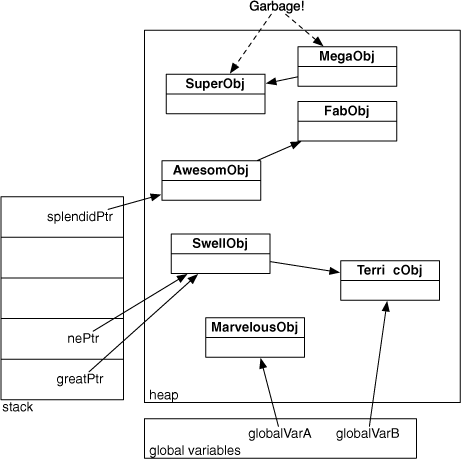Garbage Collector in Cocoa Programming in Mac
By: Aaron Hillegass in Cocoa Tutorials on 2010-09-24
As long as you use only Objective-C objects, the garbage collector will do exactly what you want, without your needing to think about it. However, as soon as you start to malloc C data types and Core Foundation structures, you will need to be a bit more circumspect.
When the garbage collector runs, it is looking for unreachable objects. You can think of the objects in your applications as a directed graph: This object knows that object; it knows those objects; and they know those other objects. So, the garbage collector starts with the pointers on the stack and the global variables and wanders this directed graph until it has recorded every "reachable" object. The unreachable objects are deallocated. See Figure below.
Figure: Reachable Objects

Before an object is deallocated by the garbage collector, it is sent the finalize message. Overall, you shouldn't need to implement finalize very often, but if you do, it looks like this:
- (void)finalize
{
...Do some last minute stuff here...
[super finalize];
} Add Comment
This policy contains information about your privacy. By posting, you are declaring that you understand this policy:
- Your name, rating, website address, town, country, state and comment will be publicly displayed if entered.
- Aside from the data entered into these form fields, other stored data about your comment will include:
- Your IP address (not displayed)
- The time/date of your submission (displayed)
- Your email address will not be shared. It is collected for only two reasons:
- Administrative purposes, should a need to contact you arise.
- To inform you of new comments, should you subscribe to receive notifications.
- A cookie may be set on your computer. This is used to remember your inputs. It will expire by itself.
This policy is subject to change at any time and without notice.
These terms and conditions contain rules about posting comments. By submitting a comment, you are declaring that you agree with these rules:
- Although the administrator will attempt to moderate comments, it is impossible for every comment to have been moderated at any given time.
- You acknowledge that all comments express the views and opinions of the original author and not those of the administrator.
- You agree not to post any material which is knowingly false, obscene, hateful, threatening, harassing or invasive of a person's privacy.
- The administrator has the right to edit, move or remove any comment for any reason and without notice.
Failure to comply with these rules may result in being banned from submitting further comments.
These terms and conditions are subject to change at any time and without notice.
- Data Science
- Android
- React Native
- AJAX
- ASP.net
- C
- C++
- C#
- Cocoa
- Cloud Computing
- HTML5
- Java
- Javascript
- JSF
- JSP
- J2ME
- Java Beans
- EJB
- JDBC
- Linux
- Mac OS X
- iPhone
- MySQL
- Office 365
- Perl
- PHP
- Python
- Ruby
- VB.net
- Hibernate
- Struts
- SAP
- Trends
- Tech Reviews
- WebServices
- XML
- Certification
- Interview
categories
Related Tutorials
Listing of files in a tar file in Mac OS X.
Listing of files in a zip file in Mac OS X.
Multithreading versus Multiprocessing in Mac OS X.
Using NSOpenGLView in Cocoa Programming in Mac
Garbage Collector in Cocoa Programming in Mac
Weak References in Mac Cocoa Programming
Web Services in Mac Cocoa Programming
Printing in Mac Cocoa Programming
What is Cocoa? A brief history of Cocoa.
Programming Language used in Cocoa Programming
Objects, Classes, Methods, and Messages in Cocoa Programming
Comments